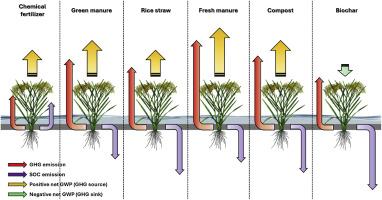Dilemma of organic matter input to mitigate climate impact of rice paddies
IF 10.3
1区 农林科学
Q1 SOIL SCIENCE
引用次数: 0
Abstract
Soil can act as either a source or sink of atmospheric carbon (C). Organic matter application can sequester carbon dioxide (CO2) through negative emission technologies. However, in rice paddies, organic matter application can significantly increase methane (CH4) emissions, offsetting potential climate benefits. We compared the effects of organic matter types on net climate impact by quantifying annual gaseous fluxes and soil C stock changes with CO2 equivalents. All organic amendments increased CH4 emissions (7–30 Mg CO2-eq. ha−1) compared with the no organic matter treatment (NPK). However, the increases in soil C stock (9–11 Mg CO2-eq. ha−1) were insufficient to shift the system from a net C source to a net sink, even when combined with water management strategies. In contrast, biochar increased CH4 emissions but enhanced soil C stock, leading to a net negative emission effect without compromising rice productivity. Given that rice paddies account for about 11 % of anthropogenic CH4 emissions, organic matter application requires careful evaluation to avoid exacerbating climatic impacts.


稻田有机质投入缓解气候影响的困境
土壤可以作为大气碳(C)的来源或汇。有机物质的应用可以通过负排放技术封存二氧化碳。然而,在稻田中,施用有机质可显著增加甲烷(CH4)排放,抵消潜在的气候效益。我们通过量化年气体通量和土壤C储量变化与CO2当量,比较了有机质类型对净气候影响的影响。所有有机修正均增加了CH4排放量(7-30 Mg co2当量)。ha-1)与无有机质处理(NPK)相比。土壤碳储量增加(9 ~ 11 Mg CO2-eq);ha-1)不足以将系统从净碳源转变为净碳汇,即使与水管理策略相结合也是如此。相比之下,生物炭增加了CH4排放,但增加了土壤C储量,导致净负排放效应,但不影响水稻生产力。考虑到稻田约占人为甲烷排放的11%,有机物质的应用需要仔细评估,以避免加剧气候影响。
本文章由计算机程序翻译,如有差异,请以英文原文为准。
求助全文
约1分钟内获得全文
求助全文
来源期刊

Soil Biology & Biochemistry
农林科学-土壤科学
CiteScore
16.90
自引率
9.30%
发文量
312
审稿时长
49 days
期刊介绍:
Soil Biology & Biochemistry publishes original research articles of international significance focusing on biological processes in soil and their applications to soil and environmental quality. Major topics include the ecology and biochemical processes of soil organisms, their effects on the environment, and interactions with plants. The journal also welcomes state-of-the-art reviews and discussions on contemporary research in soil biology and biochemistry.
 求助内容:
求助内容: 应助结果提醒方式:
应助结果提醒方式:


